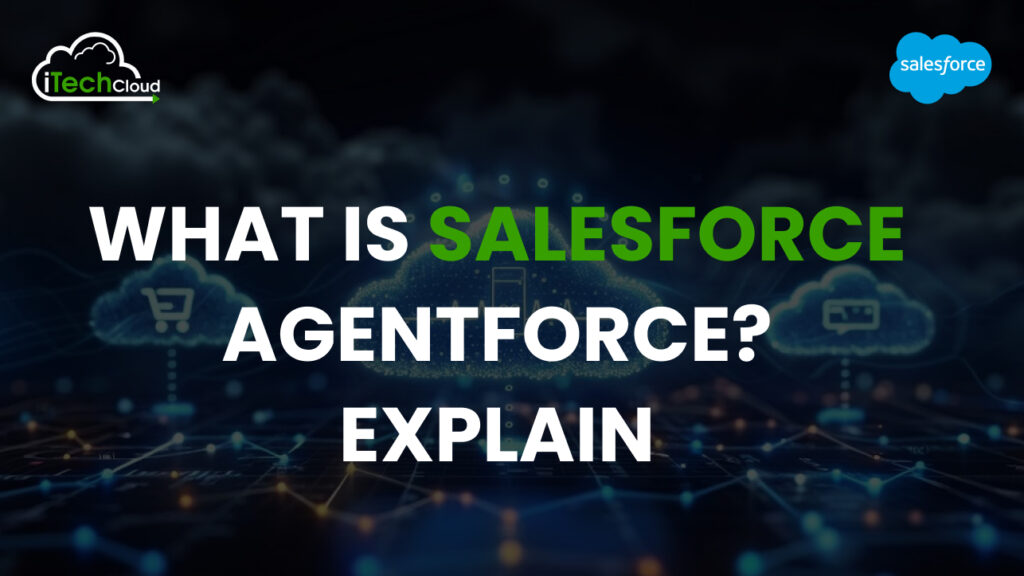What is Salesforce Agentforce? Explain

Salesforce Agentforce is an AI-operated platform designed to create and manage an autonomous agent that helps businesses with customer interaction and internal workflows. It was launched in September 2024 and benefits the LAR Sangy Model (LLM) to automate tasks such as e-mail drafts, customer support, and engagement sequencing. Agentforce scalable provides the AI solution, starting at $ 2 per conversion and integration into Salesforce products. Commercial builders can activate it using the tool and adapt agents to meet specific requirements.
Table of Contents
What is Salesforce Agentforce
Salesforce Agentforce is a platform designed to increase the efficiency of sales, customer service and field service teams, which is able to access customer data in real time by integrating autonomous AI agents, using advanced collaboration equipment and taking advantage of AI-operated insights. These agents automate different tasks so that human employees can focus on more strategic activities, which improves operating performance and customer satisfaction.
How does Salesforce AgentForce Work
1. Autonomous operations:
Agentforce is autonomous and does not need any human input to execute operations. It is able to reason with complex requests, acquire accurate information and act on it based on its purpose
2. Adaptation:
The agent enables the builder users to develop and adjust agents via natural language instructions. The low code platform provides an easy means to customize agents for particular business needs without needing higher growth knowledge.
3. Integration with Salesforce System:
Agentforce is first integrated with Salesforce offerings like Celler Cloud, Service Cloud and Marketing Cloud that offer an integrated experience across various departments.
4. Scalability:
Agentforce is capable of scaling to fulfill growing business needs, thereby ensuring efficiency as an extension of the organization
5. Task Automatization:
It automatically exercises a large number of tasks and frees employees to work on strategic functions. These involve customer service, sales, marketing and trading functions.
6. Wise Insight:
Agentforce gives good insights and suggestions based on data analysis, supporting data-driven decisions.
7. Natural Language Processing (NLP):
It interprets and answers questions regarding natural languages, and provides easy interaction with systems.
When did Salesforce Launch Agentforce
Salesforce announced Agentforce, its independent AI agent platform, at the Dreamforce conference in September 2024. The platform went generally available on October 29, 2024. Salesforce later rolled out an updated version, Agentforce 2.0, on December 17, 2024.
How much does Salesforce Agentforce Cost
Salesforce Agentforce is $2 per conversation, and a conversation is any customer interaction within a 24-hour window. Salesforce Foundations users get 1,000 free conversations and 250,000 Data Cloud credits. Up to 200 Einstein AI requests are included per conversation, with unused requests rolling over. If a conversation is more than that, extra requests are taken from the overall pool. Volume discounts apply for companies with high volumes of conversations.
How to Enable Agentforce Salesforce
1. Access Salesforce Setup:
- Log in to your Salesforce account.
- Click on the gear icon in the upper right corner and select “Setup.”
2. Enable Einstein Features:
- In the Setup Quick Find box, type “Einstein” and select “Einstein Setup.”
- Click the “Turn on Einstein” toggle to activate Einstein features.
3. Activate Agentforce:
- In the Setup Quick Find box, type “Agents” and select “Agents” under “Agent Studio.”
- Toggle the “Agentforce” switch to “On.”
4. Create a New Agent:
- Click the “+ New Agent” button.
- Choose “Agentforce Service Agent” as the agent type and click “Next.”
- Select the relevant topics for your agent to handle and click “Next.”
- Configure additional settings as needed and click “Create.”
5. Customize Agent Topics and Actions:
- After creating the agent, you can customize its topics and actions to align with your business processes.
- For example, you can add or remove topics like “Account Management” or “Order Inquiries” based on your requirements.
6. Test the Agent:
- Use the Agent Builder’s testing features to simulate interactions and ensure the agent responds appropriately.
What LLM does Salesforce Agentforce Use
Agentforce from Salesforce relies on large language models (LLMs) designed by Salesforce AI Research, namely CodeGen2.5 and xGen-Code.
1. CodeGen2.5 is geared for applications such as code completion to improve coding accuracy and speed.
2. xGen-Code is built to manage intricate, multi-turn interactions and dynamic chat features, giving developers sophisticated support.
These models keep customer information safe within the Salesforce environment since they don’t depend on third-party LLMs. Agentforce’s adaptable architecture also enables organizations to integrate different LLMs depending on their individual needs and compliance needs while ensuring data security.
When did Salesforce Release Agentforce
Salesforce launched Agentforce, its agentic AI platform, in September 2024, with general availability in October 2024. This platform was created to automate workflows and support customer interactions through AI-driven agents.
Then, on December 17, 2024, Salesforce launched Agentforce 2.0, which introduced significant improvements like pre-configured AI skills, more integrated workflows, and the capacity to deploy AI agents natively in Slack.
Most recently, on March 6, 2025, Salesforce introduced Agentforce 2dx, with an emphasis on speeding up AI agent deployment through pre-configured actions and agent templates to enhance implementation speed and ease of use.
When did Salesforce Announce Agentforce
Salesforce announced Agentforce on September 12, 2024, as an AI-driven platform designed to automate business tasks. The platform officially became generally available on October 25, 2024. Later, on December 17, 2024, Salesforce introduced Agentforce 2.0, which included enhanced AI capabilities and deeper integration with Slack.
Conclusion:
Salesforce Agentforce is a game-changer in AI-driven automation, empowering businesses with intelligent workflows and seamless integrations. Launched in September 2024, Agentforce enhances productivity by automating tasks, optimizing customer interactions, and streamlining operations. With the release of Agentforce 2.0 in December 2024, Salesforce introduced deeper Slack integration and improved AI capabilities, making it even more powerful.
As businesses embrace AI, Agentforce stands out as a key innovation, transforming the way companies operate. Despite market fluctuations, its potential to drive efficiency and growth is undeniable, positioning Salesforce at the forefront of AI automation for enterprises worldwide.

